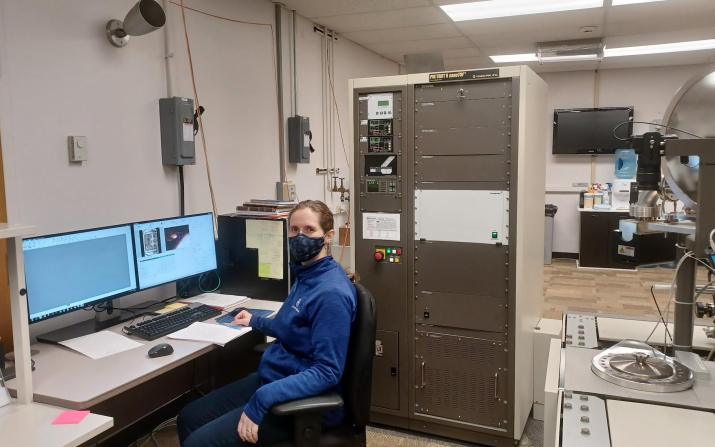SCSAM Fellow Spotlight: Laura Wilson

When Laura Wilson became one of the inaugural SCSAM Fellows, she expected to primarily use X-ray Photoelectron Spectroscopy (XPS) technique to analyze the distribution of trace phases additive manufacturing printed and feedstock powder samples. However, there was significant overlap between the photoelectron peaks of the metals and the low concentration of secondary phase that made it difficult to detect. Thus, she decided to switch to the Time-of-Flight Secondary Ion Mass Spectrometry technique (ToF-SIMS). Since ToF-SIMS relies on the ion mass to detect chemical distributions,, it does not have the same issue with the trace phase and metric phase. Once she began using ToF-SIMS, she was able to achieve her goal of resolving the amount of oxide coating on the surface of the powder and dispersed throughout the printed materials of her oxide dispersion strengthened samples.
As a PhD candidate in Case Western Reserve University’s Department of Materials Science and Engineering, Wilson is a veteran of image analysis, but the spectral data of atomic masses she gathered from the ToF-SIMS was a new type of data analysis for her. She now wants to design more experiments using ToF-SIMS to answer questions she still has for her research thesis. John Kim, SCSAM Engineer, is excited about the results. “The primary goal of the SCSAM fellowship is to reduce the risk barrier to trying new techniques so that unexpected advances in scientific study can emerge. Laura has a very good grasp of the technical aspects of the instruments and consequently good understanding of how the data should be interpreted,” said SCSAM engineer John Kim, who worked with Wilson on the XPS and ToF-SIMS.
"Just with brief data analysis, I was able to relate the TOF-SIMS data to some data we had collected near the beginning of my thesis work,” said Wilson. “It was exciting to be able to relate qualitative early results with semi-quantitative results from the SCSAM Fellowship work.”
Prior to starting her PhD studies at CWRU, Wilson was a microscopy specialist at GE Aviation, where she evaluated aviation materials using electron microscopes. It was her time at GE that motivated her to pursue a PhD in materials science and engineering after earning her B.S. and M.S. in geology from Michigan Technological University and Miami University respectively. “Coming from a geology background, the analyses were familiar, but the materials were not,” Wilson said of her experience. “I was enjoying what I was doing, but wanted to know more about the materials.”
During her time at CWRU, Wilson has taken full advantage of the opportunities available to her at SCSAM. This fall, she was one of three CWRU students to participate in a partnership between CWRU and The Ohio State University that gives CWRU students remote access to Ohio State’s transmission electron microscopy facilities. She was among the first CWRU students to use SCSAM’s newest instrument, the Apreo scanning electron microscope. As a trained, “super-user” of the Apreo, Wilson has taken advantage of multiple capabilities of the system such as collecting secondary electron images, backscattered electron images, energy-dispersive spectroscopy data, and electron backscatter diffraction patterns on her samples. Additionally, she has collected images of the porosity of her printed samples using SCSAM's Keyence.

